The appeal is obvious. What pilot doesn’t like the idea of flying faster? Even those of us who enjoy low-and-slow Part 103 ultralights remain intrigued by the idea of going fast, eating up the miles en route to a destination. [Article updated 5/31/21 with additional information. —DJ]
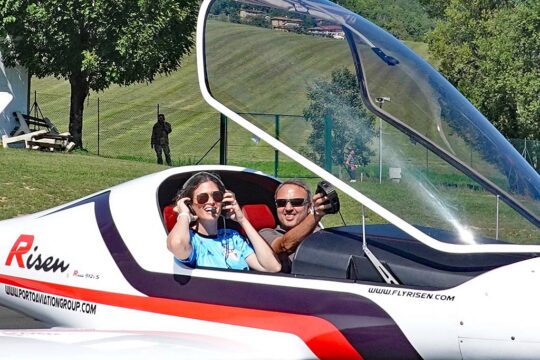
Alberto Porto put a smile on the face of Troy Jones’ daughter after flying in Italy.
Since I first saw this aircraft when it was unveiled to the world at Aero 2015, I have kept my eye on Risen. It was clear this design was going places… literally.
I used a bit of English humor in the lead photo saying “Risen Shine,” meant to play off “Rise and shine,” a get-out-of-bed-and-get-to-work phrase common in the U.S. The truth is, you don’t pronounce it RYE-sen. Porto Aviation Group marketing man Stéphan D’haene clarified that they say REE-sen.
However you may say the name, Risen is one ripping-fast aircraft. Below you’ll read about its latest speed record but Americans may be interested to hear the first example is now tearing up the skies over Montana.
First in America
At the end of 2020, on December 10th Porto Aviation Group celebrated an accomplishment: “We got the first ‘November’ tail in the air.” They refer to a a Risen with N-numbers on it as the first U.S.-registered model in America.
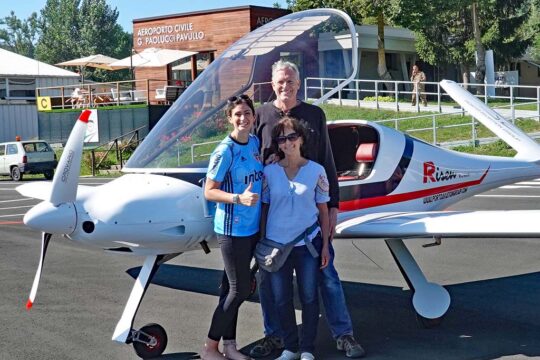
A family that flies together, visiting Risen at its home airfield.
Their launch customer is a long, tall medical doctor looking for a fast, efficient, and economical commuter and travel aircraft. “Troy Jones was exhausted with long car drives and hotel overnights,” said Porto Aviation. “He preferred to fly his own aircraft so he could get home to his family by end of day.”
Jones stands 6 feet 9 inches so finding an aircraft that could accommodate his tall frame was not easy. After discovering Risen, Troy emailed with designer Alberto Porto subsequently booking a trip to Italy to see if he actually fit.
According to Porto, Risen has “a fully modular cockpit that can be adjusted to any owner requirements.” They believed the sleek aircraft could easily accommodate a pilot of Troy’s height. It did and a purchase was arranged.
In 2019 and early 2020, before Covid, Troy spent time in Italy building his Risen using Porto Aviation’s building-assist program. His family joined him, enjoying the beautiful surroundings of Lake Como and the Italian Alps while Troy worked on his aircraft. Porto is located near the Swiss/Italian border.
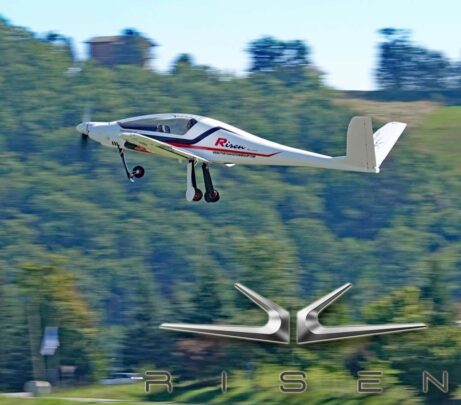
Checking out Risen at Porto’s home airfield in northern Italy; gear is shown partially retracted.
As summer 2020 arrived, the building was completed and Porto Aviation finished the task by painting the aircraft and packing it in a standard 20-foot container for shipment to the USA. After long delays related to Covid, Alberto Porto traveled in early December to Lander, Wyoming to be present during the aircraft inspection by a DAR. Giving his first U.S. bird a careful introduction, Alberto provided ground training with Troy and his flight instructor, John Larsen.
Including his 40 hours of flying in a designated area as is common for all Experimental-Amateur Built aircraft, Troy has now logged about 50 hours in the 48-inch-wide speed machine. His Risen is powered by a turbocharged Rotax 914 as Lander airfield (KLND) has a 5,588 foot field elevation. With this engine, his Risen can handle the density altitude well and can hit 200 knots while boasting a typical cruise of 180 knots. Climb exceeds 1,500 feet per minute.
Amplifying its speedy ways, Risen boasts a most impressive 23:1 glide ratio. A shorter wing version is also available.
Troy’s Risen is equipped with a Dynon HDX system combined with Garmin’s latest GPS navigator for IFR compliance. The Italian company also offers a full Garmin suite.
If you are intrigued by Risen but not sure you want the cost, complexity, or maintenance of a retractable-gear aircraft, Porto Aviation offers a fixed-gear version called Siren. Besides stiff-legged gear, Siren uses a simpler split flap system.
400-Kilometer Barrier Falls
Porto Aviation excitedly released this news: “Friday early morning, April 16th 2021, Alberto Porto and Yasemin Arslan van Deursen flew a Risen to 400.45 kilometers per hour (248.8 mph) on a 15-kilometer straight course, a first for any [European] ultralight.
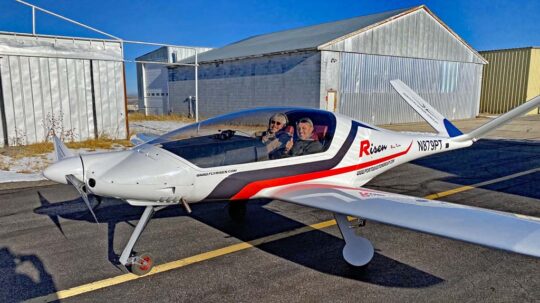
Alberto Porto gives further instruction to instructor John Larsen.
On the same day Porto and van Deursen flew another record: a new all-time high record 378.94 kilometers per hour on a 50-kilometer triangle track.
Staying within European guidelines, the speedy Risen weighed a maximum of 472.5 kilograms (1,042 pounds) and demonstrated stall at less than 65 kilometers per hour or 35 knots). While the Europe-wide EASA now has a 600 kilogram (1,320 pound) class matching international LSA, individual European nations also have the “ultralight” class. In this classification, max weights are 450 kilograms without an emergency airframe parachute or 472.5 kilograms when so equipped; parachutes are mandatory in Germany and other nations accept this safety allowance.
Powered by the same standard 115 horsepower Rotax 914UL engine, Risen was exactly the same ultralight (serial number) that set previous records on December 15th, 2019. The same sponsor stickers still appear on the fuselage.
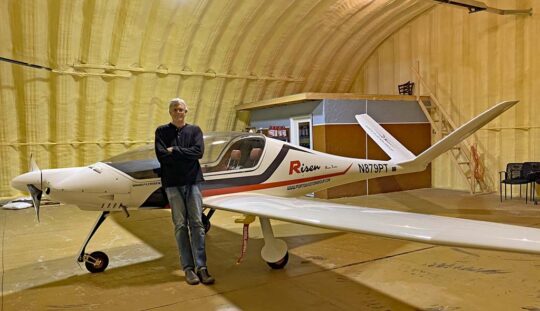
Troy Jones’ Risen is now N-numbered, based in Montana, and free to fly American skies.
Some give-and-take between producers of speedy light aircraft — reported here — prompted Alberto Porto go show his design’s prowess in a more similar comparison. FAI record attempts are done in multiple categories to accommodate aircraft of many types. Of course, rules exist for each of them but rules are sometimes changed or viewed differently by new judges. Rather than getting caught up in rule writing, Alberto vowed to recover his record.
For technical people, Porto Aviation wrote, “The 2015 Risen 912ULS record (323.84 km/h or 175 knots) was beaten in 2019 by the Risen 914 (337.51 km/h or 182 knots). Both are MSL and ISA and you are comparing apples with apples. It’s a difference in speed that is in line with the increase of horsepower, laws of physics-compliant. Yet, we claim today with the same Risen 914 at FL100 a speed of 400.45 kilometers per hour or 216 knots.”
“Can anyone see us claiming that our Risen 914 is now 62.94 kilometers per hour (34 knots) faster than the same Risen 914,” Porto Aviation asked? “Of course not. It’s still exactly the same aircraft, but at different flight conditions.”
This article explains the record-setting task in more detail. For now, suffice it to say that whatever the records body, FAI, says, Troy Jones’ Risen is one of the fastest light planes in the USA. I’ll bet it won’t be the last.
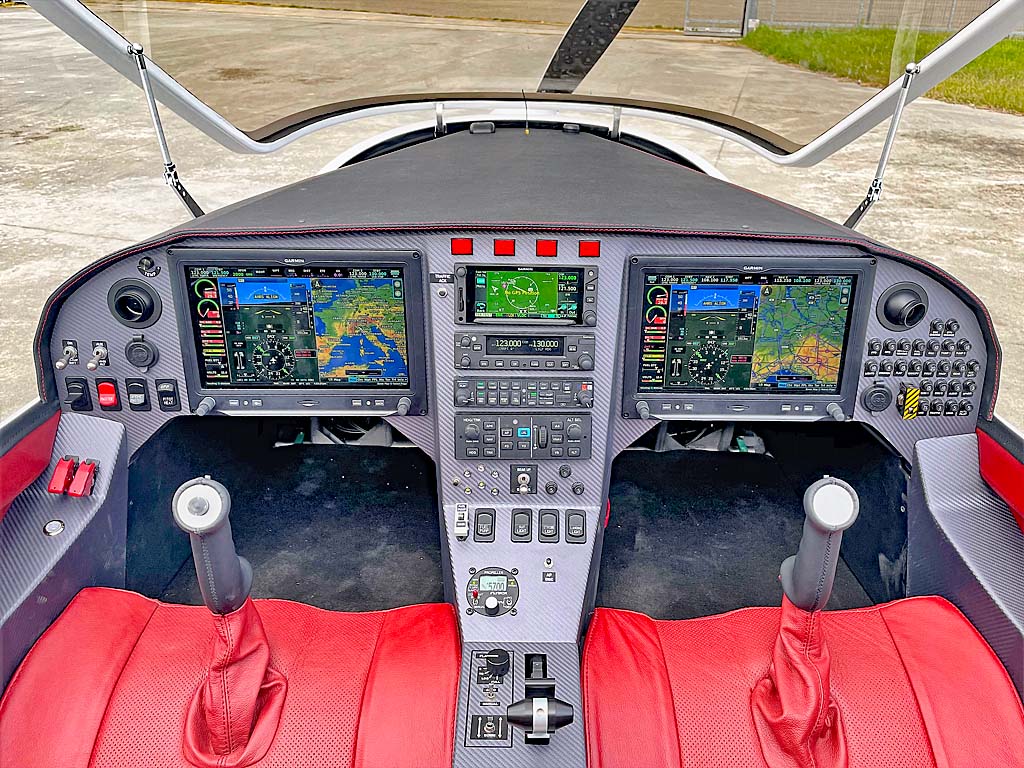
Porto Aviation is now offering this full Garmin suite in Risen.
The followings video, recorded at Aero 2015, has been viewed more than 600,000 times. The design was new then but it has continued to attract interest. Designer Alberto Porto shows us around his intense speed machine. The company website changed since the video was uploaded. Go here for more.
A few readers asked if Risen uses flaperons. This image shows the answer and further reveals the air-flow efficiency of Fowler flaps plus the compound shape of the leading edge.


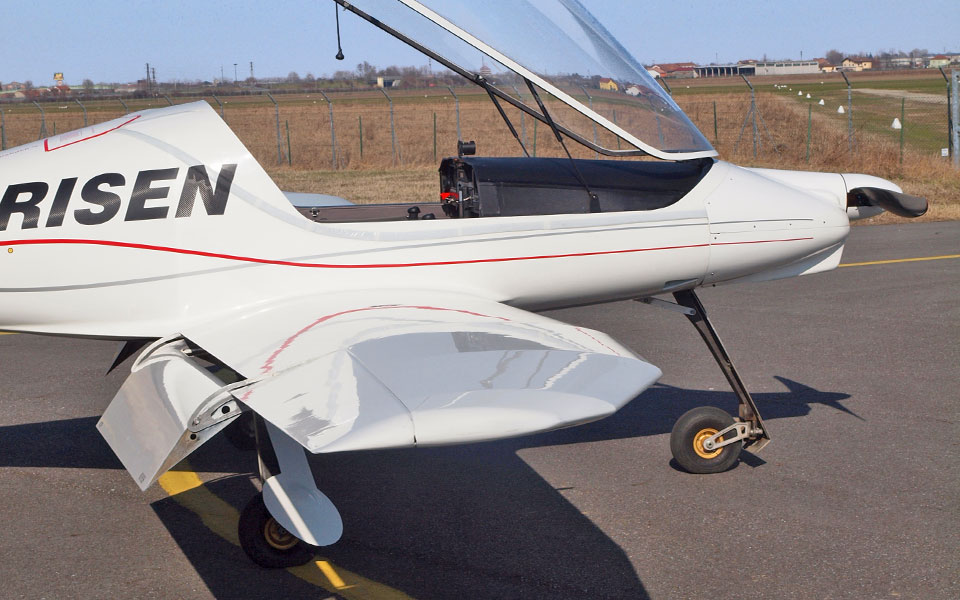
I just flew the JMB this week and was quite impressed. I live in Tennessee and would like to go and see this aircraft. Can you tell me where your closest aircraft is located? I am willing to travel to look at one as I believe it to be worthy of serious consideration.
I recommend you use links in a JMB article to contact the supplier. Use the Search bar if you don’t know how to find it.
I have airframe #23 on order and cost to me is well under $240,000.
Well done Dan. This whole drama has been one that tests your writing skills, being objective and really telling it as it is. You pass with flying colors!
As you know I have been a great fan of Alberto Porto’s work. He seems to get more from the Computational Fluid Dynamics than anyone I have come across. But his other expertise in eliminating everything that can be removed so that only the best is left, is unique to plane building. But he proved it certainly works and the numbers tell the story.
This plane is exceptional on so many levels. For such a small plane, it cuts through the air like it wasn’t there.
Simply an amazing plane.It does what others don’t and can’t do. Just look at the stats and soon you say… WHAT? …HOW DID HE DO THAT!?
Spectacularly beautiful plane with amazing specs. Costs are up past $240,000-300,000 but worth it if the LSA changes happen.
Sort of a light Bonanza. I’d like to see how it stalls, especially in a low-speed turn.